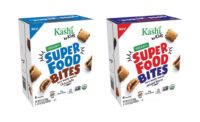Latin American snack inspirations

Food manufacturers naturally want to know which up-and-coming, on-trend flavors and ingredients will take the world by storm. No one has a crystal ball. But one thing we’ve always had is chefs and restaurants.
Just consider the range of heat-and-serve snacks and appetizers items such as heat-and-serve chicken wings, mozzarella sticks, taquitos, interesting flatbreads, breaded mushrooms, and more that fill the frozen foods aisle. All of those craveable foods, and many more like them, were born on restaurant menus around the globe.
While the fine-dining foodservice segment still inspires trends that transcend the white tablecloth to appear on grocery shelves, what’s different today is that other industry segments, such as quick-service and even colleges and universities, are influencing what Americans eat at home and on the run.
So as we seek “the next big thing” that will make a big splash in snack food product development, we can include foodservice as a reliable beacon showing us what consumers want. And of several culinary directions trending in 2020, one of the greatest is Latin American.
For example, mango as a flavor and ingredient still sways snackers, according to The Food Channel’s “2020 Food Trends.” The Food Channel’s analysis points out that things that aren’t technically even flavors are now considered flavors, such as “churro flavored.” Latin, just as other global cuisines, will play a huge role in new product rollouts this year, and cotija and epazote are simply early in the alphabet. Meanwhile, we’re all looking at the food and flavors from Brazil.
A new (to Americans) flavor from Mexico is papalo, an herb much used by people of Pueblo. It has been making its way north to land on U.S. menus, according to the “2020 Food & Beverage Trend Report” from Baum+Whiteman, which describes papalo as tasting akin to a combination of cilantro, arugula, and nasturtium leaves. Baum+Whiteman is also predicting more menu mentions of ever-fancier churros in 2020.
In its “What’s Hot” survey of more than 600 culinary professionals by the National Restaurant Association in partnership with Technomic, “sweet heat” was identified as the top flavor expected to experience growth in foodservice demand in 2020. “New” chile peppers follow close behind. Both findings open the door to more Latin inspiration in snacks.
As consumers’ global palates continue to expand, greater interest in snacks that capitalize on these flavor and ingredient trends is sure to follow. In fact, expect the happy marriage of sweet and heat to yield more spicy chocolates and show up in bakery snacks.
NRA’s “What’s Hot” survey lists South American as the second-most-popular global cuisine to grow in 2020. In South America, appetizers that might be snacks of the future serve as both first courses and finger foods. Most Latin American parties feature trays of the latter: bite-size bocaditos (“little bites,” a Spanish tradition), allowing guests to sample everything without filling up.
Not to be confused with Spanish tapas, which in foodservice are essentially artfully composed plates in miniature, many typical bocaditos are already appearing as heat-and-serve snacks in the frozen aisle, including: mini empanadas in varieties such as chicken, cheese, pizza, etc.; Venezuelan tequeños, which are pastry-wrapped bites of salty white cheese, deep-fried golden and crispy (a Latin version of mozzarella sticks); Brazilian breaded and fried risoles (an import from Indonesia), small savory pastries filled with chicken and cheese; and boliarepas, which are smaller versions of Colombian corn cakes filled with bacon and Cheddar cheese. An Argentinian take on bocaditos is the picada (from the Spanish verb picar, “to pick”), which is a visually striking tray of finger foods for everyone to share—“pick at”—while they enjoy wine or beer and socialize.
Finally, the potato chip might meet its match in 2020, more often than not bearing a Latin spin. As healthier snack options with ingredients such as chickpeas, lentils, beets, and other richly colored vegetables, as well as ingredients like quinoa, farro, and sorghum, enter the market, Benchmark, a global hospitality company, predicts these alternatives will begin to satisfy the cravings of more and more consumers.
Looking for a reprint of this article?
From high-res PDFs to custom plaques, order your copy today!





